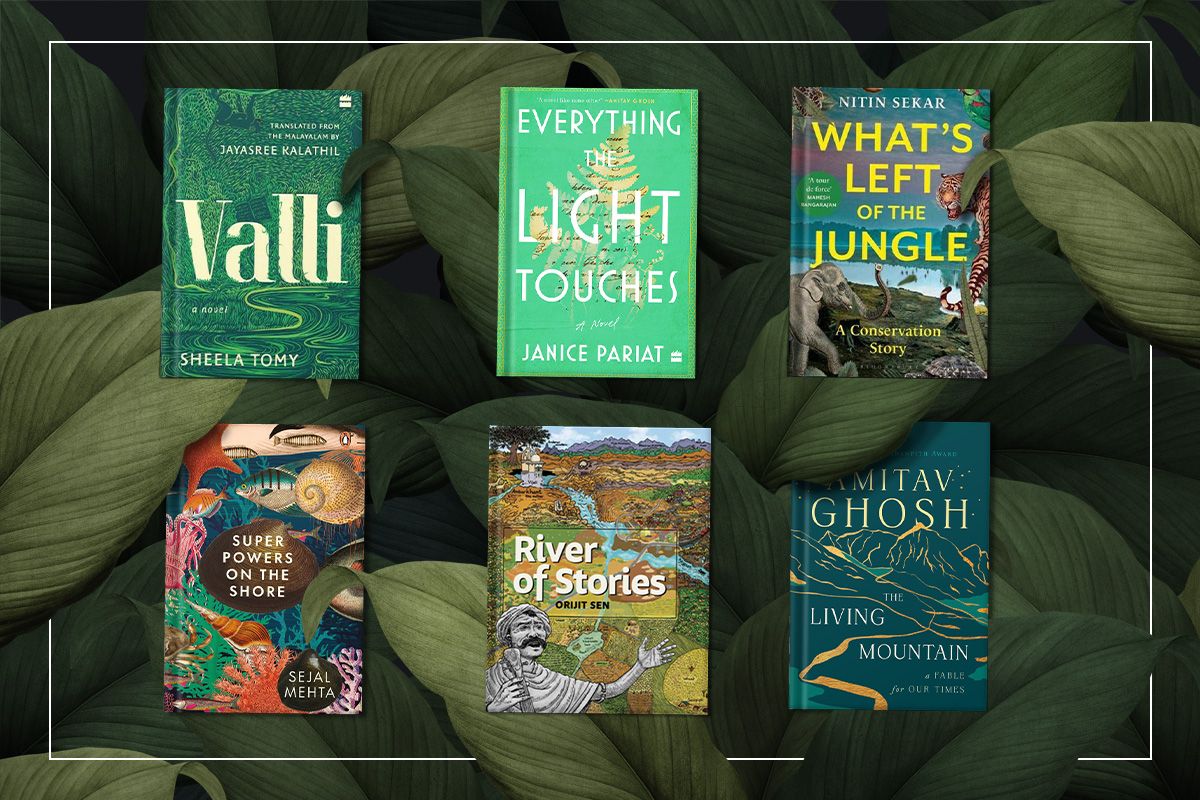
Our survival as a species depends entirely on nature, and yet our attitude towards preserving the health of the planet is horrifyingly myopic. These 2022 books reminded us yet again of our environment’s beauty, importance, and fragility—and the urgency of protecting it. By Paridhi Badgotri
You’d think that amid a lethal global pandemic, changing climate patterns leading to natural catastrophes, and deadly pollution, we wouldn’t need reminders to take care of the planet. Yet, our collective denial and negligence forces the hand of writers and artists. This year, too, we saw some remarkable works of the written word that left us breathless (quite literally in Delhi!).
Sheela Tomy’s debut novel in Malayalam, Valli, was reborn this year with Jayasree Kalathil’s English translation and was promptly shortlisted for the 2022 JCB Prize for Literature. As you turn its lush green book cover, Valli begins with a haunting sense of nostalgia: “There was a time when Kalluvayal was a dense, deep forest.” Set high in the Western Ghats in northern Kerala, it paints a landscape shrouded in mist and mystery—forests teeming with the folklore of the indigenous people: the Adivasis. Spanning four generations of people who call this place their home, this eco-fiction narrates the exploitation of their pristine land—by traders, colonialists, migrants from the lowlands, and the timber and tourist industries—and the resulting erosion of Adivasi culture, and their resistance.
Another 2022 release that spans not only centuries but also continents is Janice Pariat’s Everything the Light Touches. Pariat’s book weaves together the journeys of four people—they are seemingly disconnected in time and place but look closer and all is connected. The novel draws from two historical narratives: one of German playwright-novelist-scientist Johann Wolfgang von Goethe’s 1787 tour of Italy and the other of Swedish botanist Carl Linnaeus’s famous expedition to Lapland in 1732. It also creates two fictional ones: an Indian girl, Shai, who travels from New Delhi to her hometown in the northeast and discovers the nature-aligned lifestyle of its indigenous, and a botanist from Cambridge, Evelyn, who undertakes a sea voyage from England to India in 1911 in the search of a plant.
This year has been kind to non-fiction readers as well. Two books that we highly recommend for your shelves: Superpowers on the Shore by Sejal Mehta and What’s Left of the Jungle: A Conservation Story by Nitin Sekar. While Mehta’s book serves up some miraculous discoveries along India’s shoreline, Sekar’s novel-like account of the people and wildlife living in the woods tugs on the forces that govern our lives. Both of these books add new flavours to Indian nature writing. On one hand, Mehta makes you marvel at the ‘superpowers’ of creatures that live in tide-pools, like sea urchins that wear leaves on their spikes for camouflage, barnacles that colonise coasts, and hermaphrodite flatworms that battle with their genitals to decide who gets pregnant. On the other hand, Sekar’s sharp prose—which focusses on the villagers of Buxa in West Bengal and their forest—makes a strong argument for the country’s forest dwellers as the best guardians of its natural wealth.
The year also witnessed the reprint of what was arguably India’s first graphic novel, originally published in 1994. After nearly three decades, Orijit Sen’s River of Stories continues to be one of the most relevant and urgent stories we need. The new 25th-edition features forewords by Arundhati Roy and Paul Gravett. With captivating illustrations, the book puts the spotlight on the Narmada Bachao Andolan—and the relocation of Adivasi people. Drawing from his personal experiences of the movement, Sen weaves the history of resistance movements with tribal folklore in this timeless graphic novel.
This 2022 list would have been incomplete without a work by India’s most prolific and persuasive voice in the field: Amitav Ghosh. This year, he released The Living Mountain, a fable that serves as a cautionary tale against exploitation of nature. In just 35 pages, Ghosh reminds us of our natural relationship with the planet’s resources, and the disasters that inevitably occur when greed takes over. Having just survived a pandemic caused by a virus that originated in another species, we’d all do well to listen.
Let’s start the new year with a resolution to do our bit for the conservation of nature. If you need reading material, we have an extensive collection spanning genres at Kunzum, including but not limited to these remarkable books. Tell us what you enjoyed reading this year and what you’d like to read in 2023, in the comments!
Related: Book Trends of 2022: The Partition Revisited, 75 Years On

2 thoughts on “Book Trends of 2022: A Year that Saw Indian Writing Focus on the Climate Crisis and the Best Guardians of Nature”